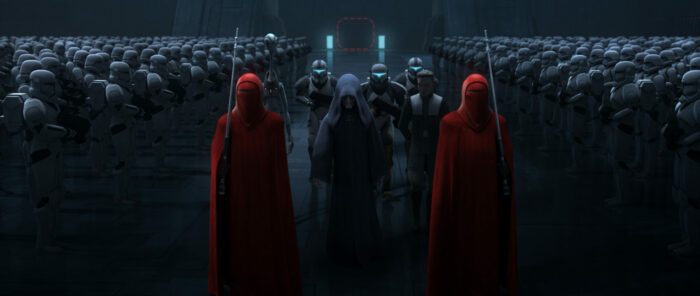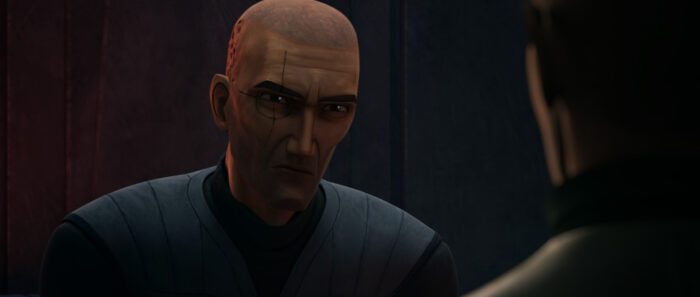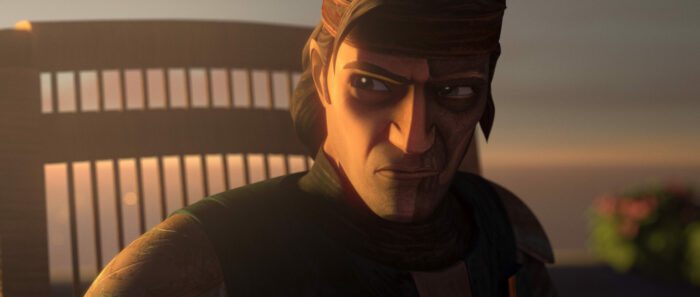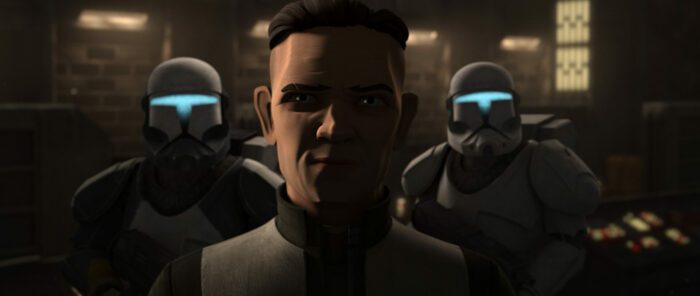The following review contains some light spoilers for Star Wars: The Bad Batch Season 3, with eight episodes watched for review
It’s not Star Wars if someone isn’t being rescued. Whether it be Princess Leia (twice), Han Solo, Omega, or Crosshair, The Bad Batch treads familiar territory, but this season doesn’t go to the same extent of filler episode content as its last two seasons. Season 3 of The Bad Batch may be the best one yet. Unlike the first two seasons, the first eight episodes aren’t a series of rescue missions or bounty jobs assigned to the crew. Mostly.
They’re still there. Bounties and extractions are a common occurrence in Star Wars, as if the writers don’t have any better ideas up their sleeves, and that’s probably because they don’t. Star Wars has rarely been about the story as much as it is about the action. The action works best when it’s not dictating the story, but rather, the story is enhanced by the action.
For instance, the duel between Luke Skywalker and Darth Vader in The Empire Strikes Back works so well because of the “no, I am your father” moment. Luke and Vader bashing sabers has more to it than just mindless violence. It’s the emotional core of Luke discovering his lineage that makes the scene more memorable. Everything happening around the scene adds to the drama. Han Solo gets captured, our heroes have lost, and now they must flee the Empire so they’re not killed or taken prisoner.
What Season 3 of The Bad Batch has in common with Empire Strikes Back is that there’s a clear line of conflict where the Empire is winning. The season starts out with Omega (Michelle Ang) imprisoned at an imperial facility—the same base she’s trapped in with Crosshair. At the Imperial Base, cloning experiments are being held. What the experiments are used for is a complete mystery, but not too much of one if you’ve seen The Rise of Skywalker. It’s never explicitly told what the cloning is being used for other than it needs a high “M-count.” It’s the same M-count you’ve heard about in Season 3 of The Mandalorian. The term midichlorian has been seemingly banished from being spoken in Star Wars lore.

Yet those prequels slowly find their way into reentering the new Disney material. What was once shunned aside by the mouse house is now embraced, and rightfully so. The prequels were far from perfect. In fact, they lack some of the very characteristics a good screenplay would contain. If not for Dave Filoni being Star Wars’ janitor, where he comes in to clean up the franchise’s subpar writing, I’d not care for The Bad Batch. If the public were sold on the Clone Wars, Attack of The Clones certainly didn’t succeed. Luckily, Dave Filoni was given nothing but resources and time. His first attempt at the Star Wars universe wasn’t a successful one. 2008’s Star Wars: The Clone Wars was critically panned and didn’t leave much of an impression on fans. But that movie developed into a TV show that made people care about the prequels.
It took a while for the plot to get anywhere interesting. The first season of The Clone Wars is nothing but fighting, with no story or character development. It’s not until almost the end of the second season that we get some subtext. In Season 2 Episode 10, “The Deserter”, we get the story of a clone trooper who leaves his outpost to have a life of his own, raising a family. It’s a life the Republic can’t dictate.
Soon, more subtext was explored on the show, fleshing the clones and prequel characters out. If Ahsoka is meant to be a protector of the peace, then why do Jedi carry weapons? Why did the Clones really betray the Jedi during Order 66, and what kind of noble yet impatient man was Anakin Skywalker? Filoni and his writing team made a cartoon that gave the fans the type of Star Wars prequel they really wanted to see.
The Bad Batch continues that tradition. It’s is a show that had a rocky start. It wouldn’t be a Dave Filoni product if you didn’t get lots of episodes that are 5% story and 95% action. This time around, the first episode focuses entirely on the story instead of combat. As mentioned before, the season begins in an Imperial prison where cloning experiments are being held. They’re not for making more clone soldiers, as the Empire ceased production on cloning in Kamino in favor of getting conscripted soldiers. So, what’s the facility being used for? Cue Poe Dameron saying, “Somehow, Palpatine returned.”

Once more, Dave Filoni is issued with the task to clean up someone else’s mess. Instead of George Lucas, it’s Disney. However, it’s not primarily Filoni who’s on clean-up duty in the writing department. Departing to work on Ahsoka, Dave Filoni has given over most of the creative helms to Jennifer Corbett and a staff of writers. What Filoni, Corbett, and the team have established for this season is a promising start to what may be a tragic end for the clones.
The time we spend in the first episode at the prison builds mood and suspense. We’re not invested so much in whether Omega and Crosshair are going to escape but rather in what’s going on around them. If The Clone Wars were an end to the Republic era, then The Bad Batch would likely bring the extinction of the clones.
Within my eight episodes of viewership, there’s a clear thread leading up to what may be a clone uprising. With the clones no longer desired by the Empire, things won’t end quietly. Even clones like Crosshair, who betrayed his own brothers to stay loyal to the Empire, have switched sides. It was only a matter of time before the clones stopped working for their masters. Sadly, the uprising will be short-lived. The last words we may hear before the Clones can execute their insurrection is, “You may fire when ready.” That was already the case with Kamino, and it may be the situation with the clones at the series finale. There’s a great amount of anticipation and delivery that goes with Dave Filoni’s work. Fans familiar with him expect him to close out The Bad Batch in spectacular style. So far, Season 3 has promise.
If I’m intentionally vague, it’s so I don’t ruin the series for you. Although, to be honest, there isn’t much to spoil, just more to regurgitate. The Bad Batch Season 3 is a Dave Filoni cartoon. There’s filler, but not to the extent that the first two seasons were. Each episode so far leads to a wider plot that will eventually (better) pay off. The first episode is about Omega and Crosshair trapped in an Imperial base. Episode 2 is the Batch learning Omega’s location, with an attempt to break her out. Episode 3 is Omega and Crosshair’s escape. The rest of the episodes I wouldn’t want to spoil.

For most of the show, we follow Hunter, Echo, and Wrecker as they try to extract Omega and Crosshair from their prison facility. When all our characters reunite, we get some closure from Crosshair in Episode 5. For a long time, Crosshair pledged allegiance to the Empire until they betrayed him. The same goes for most clones who didn’t find the type of peace they were looking for after the war. The Bad Batch, at one point, catches up with familiar clone friends and goes on to rescue other clones who have been wrongfully imprisoned.
For all its strengths in building something up, Season 3 of The Bad Batch is loaded with the typical Star Wars conventions that can leave audiences bored. Characters get in fights with giant monsters, people sneak in and out of Imperial bases, and shootouts happen. It can get very repetitive. A show like The Bad Batch is best viewed on a binge-watch. Unfortunately, the episodes are released on a week-by-week basis, with the exception of the first three episodes. And for a Star Wars show, it should be no surprise that the plot is stretched incredibly thin throughout its season.
Most episodes are comprised of lots of action with little story behind them. For the story that is there, it’s enough to keep me enticed to see what the finale may bring. But it’s frustrating to wait each week for another episode that only goes so far in the story department. Why not just release all the episodes at once? Is it to keep subscribers? Unless they’re hardcore Star Wars fans, they won’t stay subscribed to Disney+ to see what happens next on The Bad Batch.
On a second note, it would be nice if the show developed the characters as something more than Star Wars Battlefront skins. What do we know more about Wrecker other than he’s a brute with a good heart? Echo was developed in The Clone Wars but plays more of a side character in The Bad Batch. Hunter, we know nothing more about him other than he’s an empathetic, strong leader. Omega and Crosshair get the most character development in the entire series.

Even if not all the clones are developed, Dee Bradley Baker’s voice-over work is nothing short of stellar. The man not only has to impersonate Temuera Morrison’s voice but put his own spin on it all while trying to have a different sound for each Bad Batch member. He does so with flying colors. You can hear each character speak with a certain pitch and tone to make them all sound uniquely different. Another strength is building Omega’s character. We see how she’s an optimistic child who wants to help others in need rather than abandon them. When stuck inside with Crosshair, it’s Omega who encourages him to break out. She also helps tame an enraged animal trapped in the Imperial jail.
The writing is surface-level. This is a children’s cartoon, after all. The Clone Wars and Rebels aren’t emotionally complicated. But these series do bring in some subtext that enhances the movies audiences once hated. Who knows? Maybe one day, after all these Filoni cartoons and upcoming projects are finished, we’ll have audiences twenty years from now praising the Disney sequels. It’s highly unlikely, but look at how nostalgia has affected the prequels.

I don’t expect the show to deliver until its last or second-to-last episode. It’s just the way these shows go. I’m hoping there’s less setup and more payoff this time around. The first eight episodes of Season 3 are setting up what might be a tragic answer to a Star Wars question: What happened to the Clones?
Although the first season answered that, we still see clones scattered across the Galaxy serving the Empire. So what happened to them? They couldn’t have all aged off. Why would the Empire want to invest in starships that easily explode, being defended by barely trained soldiers? Could it really all have been financial? Does the Empire not have close to unlimited funds? These are all questions that this show may answer in a spectacular, gripping fashion, as The Clone Wars did, even if it may not be as resonant.

